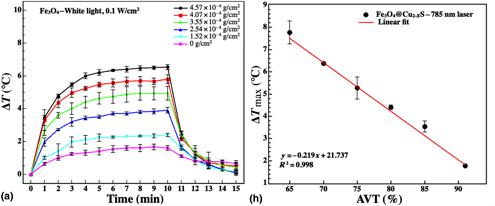当前位置:
X-MOL 学术
›
MRS Commun.
›
论文详情
Our official English website, www.x-mol.net, welcomes your feedback! (Note: you will need to create a separate account there.)
Optical thermal insulation via the photothermal effects of Fe3O4 and Fe3O4@Cu2−xS thin films for energy-efficient single-pane windows
MRS Communications ( IF 1.9 ) Pub Date : 2020-03-01 , DOI: 10.1557/mrc.2020.4 Jou Lin , Yuan Zhao , Donglu Shi
MRS Communications ( IF 1.9 ) Pub Date : 2020-03-01 , DOI: 10.1557/mrc.2020.4 Jou Lin , Yuan Zhao , Donglu Shi

|
To address critical energy issues in civic structures, we have developed a novel concept of optical thermal insulation (OTI) without relying on a conventional thermal intervention medium, such as air or argon, as often used in conventional window systems. We have synthesized the photothermal (PT) materials, such as the Fe 3 O 4 and Fe 3 O 4 @Cu 2− x S nanoparticles, that exhibit strong UV and near-infrared (NIR) absorptions but with good visible transparency. Upon coating the inner surface of the window glass with a PT film, under solar irradiation, the inner surface temperature rises due to the PT effect. Subsequently, the temperature difference, Δ T , is reduced between the single pane and room interior. This leads to lower the thermal loss through a window, reflected by the U -factor, resulting in considerable energy saving without double- or triple-glazing. Comparing with the Fe 3 O 4 coatings, Fe 3 O 4 @Cu 2− x S is spectrally characterized with a much stronger NIR absorbance, contributing to an increased PT efficiency under simulated solar irradiation (0.1 W/cm 2 ). PT experiments are carried out via both white light and monochromic NIR irradiations (785 nm). The parameters associated with the thermal performance of the PT films are calculated, including PT conversion efficiency, specific absorption rate (SAR), and U -factor. Based on the concept of OTI, we have reached an optimum U -factor of 1.46 W/m 2 K for a single pane, which is satisfactory to the DOE requirement ( 2 K).
中文翻译:

通过 Fe3O4 和 Fe3O4@Cu2−xS 薄膜的光热效应实现光学隔热,用于节能单窗格窗户
为了解决市政结构中的关键能源问题,我们开发了一种新的光学隔热 (OTI) 概念,而不依赖于传统窗户系统中经常使用的传统热干预介质,例如空气或氩气。我们已经合成了光热 (PT) 材料,例如 Fe 3 O 4 和 Fe 3 O 4 @Cu 2- x S 纳米粒子,它们表现出强烈的紫外线和近红外 (NIR) 吸收,但具有良好的可见光透明度。在窗玻璃的内表面涂上 PT 膜后,在太阳照射下,由于 PT 效应,内表面温度升高。随后,单个窗格和房间内部之间的温差 Δ T 减小。这导致降低通过窗口的热损失,由 U 因子反映,无需双层或三层玻璃即可节省大量能源。与 Fe 3 O 4 涂层相比,Fe 3 O 4 @Cu 2- x S 在光谱上具有更强的 NIR 吸收,有助于在模拟太阳辐射 (0.1 W/cm 2 ) 下提高 PT 效率。PT 实验是通过白光和单色近红外辐射 (785 nm) 进行的。计算了与 PT 薄膜的热性能相关的参数,包括 PT 转换效率、比吸收率 (SAR) 和 U 因子。基于 OTI 的概念,我们已经为单个窗格达到了 1.46 W/m 2 K 的最佳 U 系数,这满足了 DOE 的要求 (2 K)。有助于在模拟太阳辐射 (0.1 W/cm 2 ) 下提高 PT 效率。PT 实验是通过白光和单色近红外辐射 (785 nm) 进行的。计算了与 PT 薄膜的热性能相关的参数,包括 PT 转换效率、比吸收率 (SAR) 和 U 因子。基于 OTI 的概念,我们已经为单个窗格达到了 1.46 W/m 2 K 的最佳 U 系数,这满足了 DOE 的要求 (2 K)。有助于在模拟太阳辐射 (0.1 W/cm 2 ) 下提高 PT 效率。PT 实验是通过白光和单色近红外辐射 (785 nm) 进行的。计算与 PT 薄膜的热性能相关的参数,包括 PT 转换效率、比吸收率 (SAR) 和 U 因子。基于 OTI 的概念,我们已经为单个窗格达到了 1.46 W/m 2 K 的最佳 U 系数,这满足了 DOE 的要求 (2 K)。
更新日期:2020-03-01
中文翻译:

通过 Fe3O4 和 Fe3O4@Cu2−xS 薄膜的光热效应实现光学隔热,用于节能单窗格窗户
为了解决市政结构中的关键能源问题,我们开发了一种新的光学隔热 (OTI) 概念,而不依赖于传统窗户系统中经常使用的传统热干预介质,例如空气或氩气。我们已经合成了光热 (PT) 材料,例如 Fe 3 O 4 和 Fe 3 O 4 @Cu 2- x S 纳米粒子,它们表现出强烈的紫外线和近红外 (NIR) 吸收,但具有良好的可见光透明度。在窗玻璃的内表面涂上 PT 膜后,在太阳照射下,由于 PT 效应,内表面温度升高。随后,单个窗格和房间内部之间的温差 Δ T 减小。这导致降低通过窗口的热损失,由 U 因子反映,无需双层或三层玻璃即可节省大量能源。与 Fe 3 O 4 涂层相比,Fe 3 O 4 @Cu 2- x S 在光谱上具有更强的 NIR 吸收,有助于在模拟太阳辐射 (0.1 W/cm 2 ) 下提高 PT 效率。PT 实验是通过白光和单色近红外辐射 (785 nm) 进行的。计算了与 PT 薄膜的热性能相关的参数,包括 PT 转换效率、比吸收率 (SAR) 和 U 因子。基于 OTI 的概念,我们已经为单个窗格达到了 1.46 W/m 2 K 的最佳 U 系数,这满足了 DOE 的要求 (2 K)。有助于在模拟太阳辐射 (0.1 W/cm 2 ) 下提高 PT 效率。PT 实验是通过白光和单色近红外辐射 (785 nm) 进行的。计算了与 PT 薄膜的热性能相关的参数,包括 PT 转换效率、比吸收率 (SAR) 和 U 因子。基于 OTI 的概念,我们已经为单个窗格达到了 1.46 W/m 2 K 的最佳 U 系数,这满足了 DOE 的要求 (2 K)。有助于在模拟太阳辐射 (0.1 W/cm 2 ) 下提高 PT 效率。PT 实验是通过白光和单色近红外辐射 (785 nm) 进行的。计算与 PT 薄膜的热性能相关的参数,包括 PT 转换效率、比吸收率 (SAR) 和 U 因子。基于 OTI 的概念,我们已经为单个窗格达到了 1.46 W/m 2 K 的最佳 U 系数,这满足了 DOE 的要求 (2 K)。


























 京公网安备 11010802027423号
京公网安备 11010802027423号